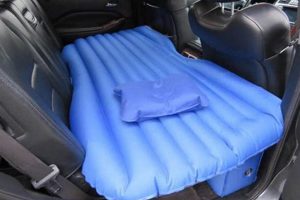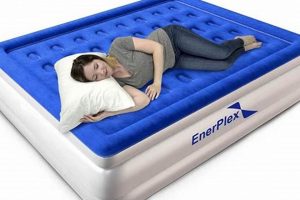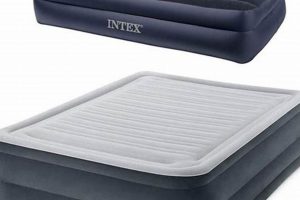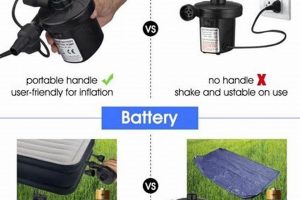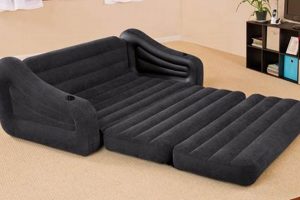An air mattress offers a portable and comfortable sleeping solution, but its utility is contingent on inflation. When a pump is unavailable, alternative methods become essential. These techniques leverage readily available resources and basic physical principles to introduce air into the mattress chamber, allowing it to achieve its intended form and function.
Circumventing the need for specialized equipment provides convenience and adaptability, especially in situations where electricity is absent or traditional pumps are misplaced. Understanding these methods expands the practicality of air mattresses, ensuring a comfortable rest regardless of circumstance. Historically, ingenious solutions have often arisen from necessity, and this situation mirrors that human capacity for resourcefulness.
The following sections will detail several effective approaches for inflating an air mattress in the absence of a pump, covering techniques ranging from employing a household vacuum cleaner to utilizing a simple plastic bag and lung power. Each method presents unique advantages and limitations, enabling one to choose the most suitable option based on available resources and environmental conditions.
Tips for Air Mattress Inflation Without a Pump
Achieving full inflation of an air mattress without a dedicated pump requires a strategic approach. The following tips optimize effectiveness and minimize exertion when employing alternative methods.
Tip 1: Utilize a Vacuum Cleaner (Exhaust Function): If a vacuum cleaner is available, check for an exhaust port. Securely attach the vacuum hose to the air mattress valve, ensuring a tight seal. Activate the vacuum in exhaust mode to force air into the mattress.
Tip 2: Employ a Hair Dryer (Cool Setting): A hair dryer on a cool setting can serve as a makeshift inflator. Similar to the vacuum cleaner, create a seal between the hair dryer nozzle and the air mattress valve. Avoid using the heat setting, as it may damage the mattress material.
Tip 3: Leverage a Large Trash Bag: Open a large, clean trash bag and capture air within it. Seal the opening around the air mattress valve, and gently squeeze the air from the bag into the mattress. Repeat the process until the desired inflation level is reached.
Tip 4: Use a Pillowcase: Similar to the trash bag method, a pillowcase can be employed to capture and transfer air into the air mattress. Ensure the pillowcase is clean and free of debris before use.
Tip 5: Manual Inflation (Lung Power): This method is the most labor-intensive but requires no additional tools. Firmly seal lips around the air mattress valve and blow air into the mattress. Take frequent breaks to avoid hyperventilation.
Tip 6: Optimize Valve Seal: Regardless of the inflation method, ensure a tight seal between the chosen device and the air mattress valve. Air leakage significantly reduces the effectiveness of any technique.
Tip 7: Pre-Inflation Preparation: Before commencing inflation, ensure the air mattress is laid out flat on a clear surface, free from sharp objects. This minimizes the risk of punctures during the inflation process.
By implementing these tips, the process of inflating an air mattress without a pump can become more efficient and less physically demanding, leading to a more satisfactory outcome.
The subsequent section will provide a concluding overview of the principles and methods discussed, reinforcing the adaptability of air mattresses in various situations.
1. Vacuum exhaust adaptation
Vacuum exhaust adaptation represents a pragmatic approach to inflating an air mattress when a dedicated pump is unavailable. This method leverages the readily accessible airflow generated by most household vacuum cleaners, redirecting it to inflate the mattress. Its success hinges on understanding airflow dynamics and achieving a secure connection.
- Hose Compatibility and Sealing
The effectiveness of vacuum exhaust adaptation relies heavily on the ability to create an airtight seal between the vacuum hose and the air mattress valve. Many vacuum hoses do not directly fit standard air mattress valves, necessitating the use of adapters, duct tape, or other makeshift sealing solutions. Failure to establish a secure seal results in significant air leakage, diminishing the inflation rate and prolonging the process.
- Exhaust Function Identification
Not all vacuum cleaners possess a dedicated exhaust port. Some models are designed solely for suction. Prior to attempting this inflation method, it is crucial to identify a functional exhaust outlet on the vacuum cleaner. Utilizing the suction port inadvertently will deflate the air mattress.
- Filtration Considerations
While the exhaust air from a vacuum cleaner is generally filtered, there is a potential for residual dust or debris to be introduced into the air mattress during inflation. This is especially relevant for older vacuum cleaners with compromised filtration systems. While typically not harmful, this may be a consideration for individuals with sensitivities to dust or allergens.
- Vacuum Motor Strain
Prolonged use of a vacuum cleaner in exhaust mode to inflate an air mattress can potentially strain the motor. It is advisable to monitor the vacuum cleaner’s temperature and avoid extended periods of continuous operation to prevent overheating or damage to the appliance. Inflating the mattress in stages, with breaks in between, can mitigate this risk.
Vacuum exhaust adaptation, therefore, represents a viable alternative to traditional pumps, contingent on proper execution and consideration of potential limitations. When carefully implemented, this method offers a convenient and effective solution for inflating an air mattress in situations where specialized equipment is absent.
2. Hair dryer (cool) airflow
The utilization of hair dryer (cool) airflow for inflating an air mattress in the absence of a pump offers a readily available alternative, albeit with specific considerations. This method leverages the forced air expelled by a common household appliance to introduce air into the mattress chamber.
- Airflow Volume and Inflation Time
Hair dryers, even on their highest airflow settings, typically generate a lower volume of air compared to dedicated air mattress pumps. This translates to a considerably longer inflation time. The process may be suitable for smaller air mattresses but becomes increasingly impractical for larger models requiring substantial air volume.
- Temperature Control and Material Integrity
Employing the cool
setting is paramount. The heated air from a hair dryer can potentially damage the air mattress material, leading to deformation, weakening of seams, or even melting in extreme cases. Consistent use of the cool setting minimizes the risk of heat-induced damage, preserving the mattress’s integrity. - Nozzle Sealing and Air Leakage
Achieving an effective seal between the hair dryer nozzle and the air mattress valve is crucial for efficient inflation. Air leakage significantly reduces the airflow entering the mattress, prolonging the process and diminishing the overall effectiveness of the method. Adapters, tape, or other means may be necessary to create a tight seal.
- Energy Consumption and Appliance Limitations
Prolonged use of a hair dryer for inflation purposes consumes considerable electrical energy. This may be a concern in situations where power sources are limited or electricity costs are a factor. Additionally, continuous operation of a hair dryer for extended periods can potentially overheat the appliance, leading to malfunction or reduced lifespan.
The integration of hair dryer (cool) airflow as an inflation method represents a compromise between convenience and effectiveness. While readily accessible, its limitations in airflow volume, temperature control requirements, and sealing challenges necessitate a careful assessment of its suitability for specific scenarios. The availability of alternative methods, the size of the air mattress, and the user’s patience level all influence the practicality of this approach.
3. Bagged air displacement
Bagged air displacement provides a low-tech solution to inflating an air mattress in the absence of a pump. This method relies on capturing air within a flexible container and then forcing it into the mattress chamber through manual compression. The effectiveness of this technique is directly proportional to the bag’s volume and the efficiency of the air transfer process.
- Bag Volume and Material
The size of the bag dictates the amount of air delivered per compression cycle. Larger bags, such as heavy-duty trash bags or large pillowcases, offer greater volume, reducing the number of cycles required to inflate the mattress. The material must be durable enough to withstand repeated handling and compression without tearing, and pliable enough to easily direct airflow.
- Valve Seal and Air Loss Minimization
A critical element is establishing an adequate seal between the bag’s opening and the air mattress valve. Any gap allows air to escape during compression, significantly reducing efficiency. Methods to improve the seal include tightly wrapping the bag opening around the valve, using tape or clamps, or employing a nozzle adapter.
- Compression Technique and Physical Effort
The method of compressing the bag influences airflow efficiency. A rolling or folding technique, combined with steady pressure, optimizes the transfer of air into the mattress. This method requires significant physical effort, particularly for larger mattresses, potentially leading to fatigue. Breaks may be necessary to sustain the process.
- Cleanliness and Hygiene Considerations
The bag must be clean and free from debris to avoid introducing contaminants into the air mattress. This is particularly important if the mattress is used for sleeping purposes. Consider using a new or thoroughly cleaned bag to maintain hygiene standards, especially when used in outdoor or less sanitary environments.
Bagged air displacement, therefore, offers a basic but potentially effective means of inflating an air mattress without specialized equipment. Its utility hinges on bag volume, seal integrity, compression technique, and hygiene considerations. When these factors are optimized, this method provides a viable alternative in situations where convenience and accessibility are paramount.
4. Lung capacity exertion
Lung capacity exertion, in the context of inflating an air mattress without a pump, refers to the physical demand placed on an individual’s respiratory system when manually providing the necessary airflow. This method, while straightforward, relies entirely on the user’s ability to forcefully and repeatedly exhale into the mattress valve, presenting certain limitations and physiological considerations.
- Volume and Inflation Rate
Human lung capacity, typically ranging from 4 to 6 liters, dictates the volume of air that can be delivered with each breath. Consequently, the inflation rate is limited by this physiological constraint. Larger air mattresses require numerous exhalations, extending the inflation time significantly compared to pump-assisted methods. Real-world scenarios, such as camping or travel where pumps are unavailable, highlight this limitation, particularly for individuals with reduced lung function or physical stamina.
- Physiological Strain and Fatigue
Repeated forceful exhalation can induce physiological strain, leading to hyperventilation, dizziness, and muscle fatigue. The prolonged effort required to inflate a large mattress manually can be particularly taxing, potentially exacerbating pre-existing respiratory conditions or causing discomfort. This exertion contrasts sharply with the minimal physical effort required when using an electric or foot pump.
- Valve Seal Dependency and Efficiency
The efficiency of lung capacity exertion is heavily dependent on maintaining an airtight seal between the mouth and the mattress valve. Any air leakage reduces the volume of air entering the mattress, necessitating more exhalations and increasing the overall exertion. Poor seal design or user error can compound this inefficiency, rendering the manual inflation method even more laborious.
- Hygiene and Contamination Risks
Direct oral contact with the mattress valve introduces potential hygiene concerns. Saliva and oral bacteria can contaminate the valve and the interior of the mattress, potentially leading to the growth of microorganisms. While generally not a significant health risk, it is a factor to consider, particularly in shared or unsanitary environments. Cleaning the valve before and after inflation can mitigate this risk.
In summary, lung capacity exertion, while a viable option for inflating an air mattress without a pump, presents inherent limitations related to inflation rate, physiological strain, valve seal dependency, and hygiene. The practical application of this method is best suited for small mattresses, short-term use, and situations where alternative inflation methods are unavailable, always keeping in mind the potential physical demands and hygienic considerations involved.
5. Valve seal optimization
Valve seal optimization directly and significantly impacts the efficiency of inflating an air mattress without a pump. The process of introducing air into the mattress chamber, irrespective of the method employed (vacuum, hair dryer, bagged air, or lung power), is conting
ent upon the establishment and maintenance of an airtight connection at the valve. Air leakage, resulting from a compromised seal, diminishes the pressure differential between the external environment and the mattress interior, substantially increasing the time and effort required for inflation. In situations where a dedicated pump is unavailable, this becomes a critical bottleneck.
Consider, for example, the attempt to inflate an air mattress using a trash bag. If the bag opening is not securely sealed around the valve, a significant portion of the displaced air will escape, rendering the process highly inefficient. Similarly, when utilizing a hair dryer, an imperfect seal necessitates continuous adjustments to maintain airflow into the mattress, diverting focus and energy from the primary objective. The consequences of inadequate valve sealing are amplified when relying on lung power, where each breath is a limited resource. The cumulative effect of even minor leaks can transform a manageable task into a protracted and exhausting endeavor.
Effective valve seal optimization, therefore, is not merely a procedural detail but a fundamental prerequisite for successful manual inflation of an air mattress. Addressing potential leakage points through the use of adapters, tape, or careful positioning of the inflation source is crucial for maximizing airflow efficiency and minimizing the physical exertion involved. Recognizing the practical significance of this aspect allows individuals to adapt their approach and prioritize seal integrity, ensuring a more effective and less demanding inflation process.
Frequently Asked Questions
This section addresses common inquiries concerning alternative methods for inflating an air mattress in the absence of a dedicated pump. It aims to provide clear and concise answers to frequently encountered questions.
Question 1: Is it possible to inflate an air mattress without any equipment whatsoever?
While challenging, manual inflation via lung power is possible, but labor-intensive. The practicality depends on mattress size and individual lung capacity.
Question 2: Can any type of vacuum cleaner be used for inflation?
Only vacuum cleaners with a functioning exhaust port are suitable. Ensure the hose can be securely attached to the air mattress valve.
Question 3: What are the risks of using a hair dryer to inflate an air mattress?
The primary risk is overheating and potential damage to the mattress material. It is imperative to use the cool setting exclusively.
Question 4: How can air leakage be minimized during inflation?
Ensure a tight seal between the inflation source and the air mattress valve. Adapters, tape, or careful positioning can improve the seal.
Question 5: Are there any hygiene concerns with manual inflation using lung power?
Direct oral contact with the valve can introduce bacteria. Cleaning the valve before and after inflation is advisable.
Question 6: What is the most efficient alternative to a pump for inflating an air mattress?
A vacuum cleaner with a functioning exhaust port, properly sealed to the valve, generally offers the most efficient alternative, balancing speed and effort.
Understanding the limitations and best practices associated with each method is crucial for successful and safe inflation.
The next section will summarize key takeaways and reiterate the adaptable nature of air mattress usage.
Conclusion
The preceding exploration of “how to blow up an air mattress without a pump” has detailed several viable alternatives to dedicated inflation devices. Methods ranging from vacuum exhaust adaptation to manual lung capacity exertion offer solutions in situations where conventional pumps are unavailable. The effectiveness of each technique hinges on factors such as equipment accessibility, seal integrity, and user effort.
The information presented underscores the adaptable nature of air mattress utility. While a pump provides the most efficient inflation method, these alternative approaches ensure the continued functionality of the mattress in diverse circumstances. The informed application of these techniques enables the practical use of air mattresses across varied environments and logistical constraints.


